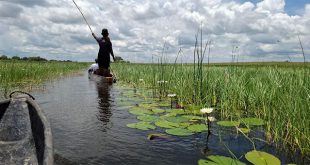
By Mubatsi Asinja Habati
Kotido is one of the oldest districts in Karamoja, an area that has often been referred to as the least developed part of Uganda. Karamoja has seen the brunt of violent cattle rustling and gun trafficking which have slowed down the general development of the area. The Independent’s Mubatsi Asinja Habati spoke to Kotido District Education Officer Ambrose Lotuke about the impact of cattle raids on formal education.
What is the education status in Kotido district like?
We are moving very well as far as the government programmes are concerned. With the introduction of Universal Primary Education we have enrolled 40% of the school going age children which is a great improvement compared to previous years. We had 2000 pupils in primary school but today we have 16,709 in 21 government schools and 5 community schools out of the 44,000 school going age children. Community schools are started by parents because of the long distance to government aided schools. Primary schools have increased from 10 before UPE, when Kotido was still Jie County, to 26 today. We have traditionally had one secondary school, Kotido SS, which has 1400 students. This is inadequate given the government policy of having a secondary school in every sub-county. We have 6 sub-counties but it’s only Kotido which has a secondary school. Even the town council does not have. We have sub-counties like Kaceri, which is 50 km from the District Education Office, but all are served by one school. So the design of Universal Secondary Education, which requires children to walk from home to school and go back, is impossible in Karamoja. We need boarding schools.
What impact does this have on education in the district?
When you have one secondary school in the district it means other programmes like UPE will hardly succeed and the only secondary school will be overcrowded because structures are very few. Irish Aid built some structures for us but they are inadequate. We are asking government to give us more secondary schools so that children who leave primary schools go to nearby secondary schools. Very few parents send their children to study in neighbouring districts. We are in urgent need for more secondary schools. Government can give us a school in the farthest sub-county of Kaceri in the north and another in Panyangara in the south.

What about private schools?
One private investor tried to start a school but it closed. The tuition fees were very high and poverty here is worrying. Government only provides for USE schools. If poverty is worrying, then parents cannot afford private secondary education. Not all Karimojong own cows as some people may think. So if you come as a private investor and say that tuition fees is Shs200,000, nobody will come to your school. Poverty is a big deterrent to private school investors here.
How many vocational schools do you have in Kotido?
As a local government we started a technical vocational school in 2004 and asked the Ministry of Education to just give it a grant. We put administrative structures with solar power five years ago. But the ministry has let us down. We have followed up the matter to no avail. We cannot manage it as local government because we have no funds to pay instructors, feed students, and provide scholastic materials because we collect very little revenue. We have only one market in the whole district which is weekly and on average collect Shs80,000 per market.
Kotido Girls Primary School was built to boost education for the girl child but you said there are more boys than girls at this school. What’s the explanation for this?
Our people think that an educated girl will not bring home cows for bride wealth. They think that when girls get educated they become “prostitutes” and stay in town. That’s the attitude we are fighting. Children in Karamoja are the main source of labour in homes. All the manyattas (huts) and fences around homesteads is a work of the girl child. A family without girl children cannot have those manyattas. Girls from homes without the fenced manyattas are considered lazy and no one will marry them. Because of these domestic chores girls are kept at home, not in schools. We are trying to sensitise the communities and have incentives for families that send children to school.
How many students from Kotido have made it up to tertiary level?
With the introduction of the district quota system at university, we have been able to send at least 33 students to university. Before this affirmative action we had major universities conducting graduation ceremonies without a single student from Kotido. In 2001, for example, I was the only student from this district who graduated from university. But today we have about 11 students every year. We get teachers from neighbouring districts. We have a few Karimojong who have gone through primary teachers colleges. They teach the lower primary classes for the thematic curriculum.
What challenges are you facing in the education service in Kotido?
Poverty is predominant in Karamoja and not every parent can afford the required basic scholastic materials. Some parents cannot bring children to school because they cannot afford a pen or a 32-page exercise book. The attitude towards formal education is a big concern. The community thinks investing in education takes a long time and returns don’t come soon. The parents have to choose between missing the bride price by taking the girl child to school and keeping the girl at home to get the bride price. School dropout rates are very high. You can enroll 3000 children in Primary One but only 300 will complete P.7. Last year we had 505 children sitting PLE (Primary Leaving Examinations) yet when they started P.1 they were more than 5000. The school completion rate in this district is 10 percent.
 The Independent Uganda: You get the Truth we Pay the Price
The Independent Uganda: You get the Truth we Pay the Price





